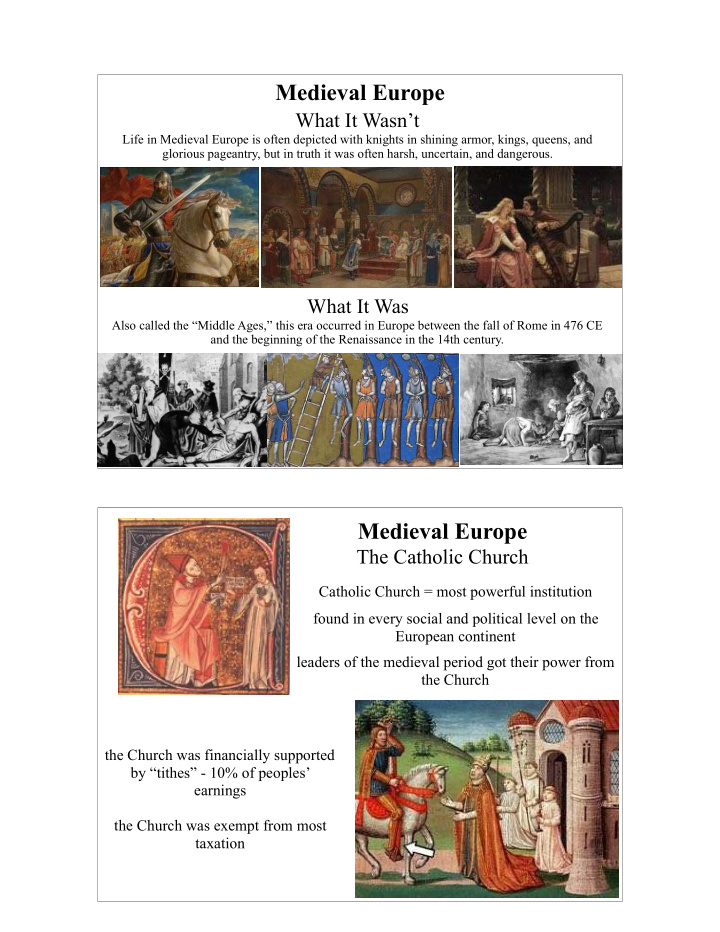



Medieval Europe What It Wasn’t Life in Medieval Europe is often depicted with knights in shining armor, kings, queens, and glorious pageantry, but in truth it was often harsh, uncertain, and dangerous. What It Was Also called the “Middle Ages,” this era occurred in Europe between the fall of Rome in 476 CE and the beginning of the Renaissance in the 14th century. Medieval Europe The Catholic Church Catholic Church = most powerful institution found in every social and political level on the European continent leaders of the medieval period got their power from the Church the Church was financially supported by “tithes” - 10% of peoples’ earnings the Church was exempt from most taxation
Hierarchy of the Church secular clergy: religious leaders who lived “in the world” parish priest: responsible for the religious instruction of his community bishop: managed a group of parishes (diocese) archbishop: managed several dioceses cardinal: highest rank of clergy adviser to the pope pope: elected by cardinals supreme authority of the church The Sacraments to receive God’s grace one must take part in the seven sacraments Penance and Baptism Reconciliation Eucharist Confirmation (Communion) Anointing of Holy Orders Matrimony the sick
Veneration of Saints Saints were men and women who were especially holy and had earned a special place in Heaven objects connected with saints called relics were believed capable of producing miracles people would make pilgrimages to visit relics The dismembered, mummified head of the revered Saint Catherine of Siena Reliquary Casket with Scenes from (1347-1380) is set in an ornate the Martyrdom of Saint Thomas Becket, Her right thumb resides reliquary in the Basilica San ca. 1173–80 in a smaller reliquary. Domenico in Siena, Italy. Medieval Europe Feudalism feudalism: system that governed rural life in KING Medieval Europe fiefs: Fief and Peasants Fief and Peasants large pieces of land the king Military Aid Loyalty LORDS (VASSALS TO KING) gave to others In exchange for their labor, serfs were serfs: allowed to live on the Food Protection Shelter Food Protection Shelter landless peasants who land and were promised Homage Military Service did most of the work protection in case of KNIGHTS (VASSALS TO LORDS) on the fiefs enemy invasion. Food Protection Shelter Farm the Pay Land PEASANTS (SERFS) Rent
Medieval Europe The Rise of Islam 632 CE: Muhammad’s death Muslim armies conquered much of the Middle East now united in cities under one caliph poets, scientists, and philosophers wrote thousands of books scholars translated Greek, Iranian, and Indian texts into Arabic inventors devised technologies: soap, windmills, surgical instruments, a flying machine, numerical system religious scholars and mystics translated, interpreted, and taught the Quran Medieval Europe The Crusades: series of military expeditions authorized by the Catholic Church to expel Muslims from the Holy Land in 1095 Pope Urban summoned a Christian army to fight its way to Jerusalem continued on and off until the end of the 15th century no one “won” and many thousands of people from both sides lost their lives united Catholics across Christendom under a common purpose and inspired waves of religious enthusiasm exposed Crusaders to Islamic literature, science, and technology Crusaders wore red crosses on their coats and believed that their service would guarantee that they could spend all eternity in Heaven
Timeline of the Crusades The First Crusade (1096 - 1099): the People's Crusade - Freeing the Holy Lands The Second Crusade (1144 -1155): led by Holy Roman Emperor Conrad III and King Louis VII of France The Third Crusade (1187 -1192): led by Richard the Lionheart of England (made a truce with Saladin), Philip II of France, and HRE Frederick I The Fourth Crusade (1202 -1204): led by Fulk of Neuil French/Flemish advanced on Constantinople The Children's Crusade (1212): led by a French peasant boy, Stephen of Cloyes The Fifth Crusade (1217 - 1221): led by King Andrew II of Hungary, Duke Leopold VI of Austria, John of Brienne The Sixth Crusade (1228 - 1229): led by Holy Roman Emperor Frederick II The Seventh Crusade (1248 - 1254): led by Louis IX of France The Eighth Crusade (1270): led by Louis IX of France The Ninth Crusade (1271 - 1272): led by Prince Edward (later Edward I of England) Medieval Europe The Decline of Feudalism 11th century agricultural innovations = more efficient and productive farming expanded and improved food supply increase in population fewer farm workers needed more people were drawn to towns and cities peddlers began to go from village to village selling goods tradesmen including included artisans, masons, and bakers, established guilds to gain higher wages for their members a commercial economy developed in cities along these expanded trade routes feudalism declined and a new era was born: the Renaissance
Recommend
More recommend